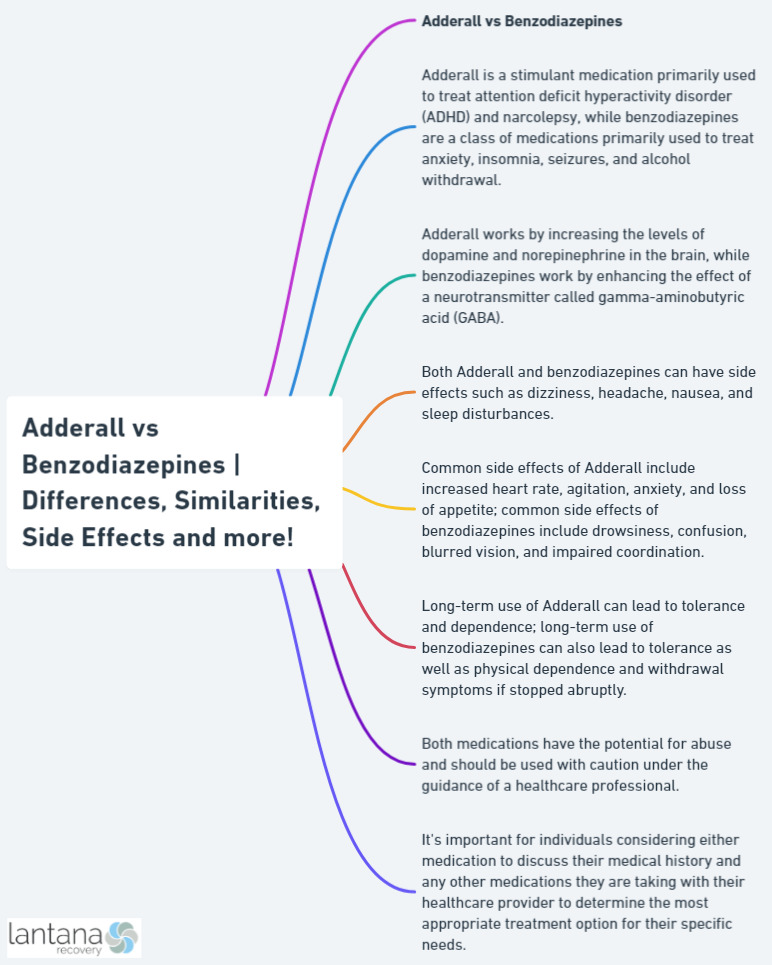There is a lot of confusion surrounding the differences between Adderall (a stimulant) and benzodiazepines (anxiety drugs). Although both types of drugs are often prescribed to treat similar conditions, there are distinct differences between them.
In this post, we’ll take a look at how these two drug classes compare in terms of their uses, side effects, and more. We’ll cover topics such as their recommended dosage amounts, potential dangers associated with each drug, information about interactions with other drugs or substances as well as any warnings that you should be aware of.
So let’s begin!
What is Adderall?
Adderall is a powerful stimulant medication that has been used to treat attention-deficit hyperactivity disorder (ADHD) since the early 1990s. Adderall is believed to boost alertness and concentration by increasing the amount of dopamine and norepinephrine available in the brain.
This can be helpful for those with ADHD who have difficulty concentrating or focusing on tasks, but could have detrimental effects on someone without an ADHD diagnosis who takes the medication recreationally. However, some people use it without a prescription for cognitive enhancement, which can lead to dependence and other serious issues if not taken with caution.
Chemical Composition of Adderall
It is composed of equal parts of 4 amphetamine and dextroamphetamine salts.
What are Benzodiazepines?
Benzodiazepines are a drug class commonly used to manage anxiety and treat sleeping issues which have been around since the 1960s. They affect a neurotransmitter known as gamma-aminobutyric acid (GABA). This neurotransmitter is responsible for reducing stress and calming nerves.
When chemically altered into benzodiazepines, it works to decrease the increasing amount of GABA to balance out its effects and reduce anxiety in patients. As such, many people with anxiety and other disorders utilize benzodiazepines in their treatment.
The various chemical compositions of benzodiazepines make each type unique to specific applications and needs, so consulting with a physician is an essential step before taking these medications.
Some common examples include Xanax (alprazolam), Klonopin (clonazepam), Valium (diazepam), Ativan (lorazepam), etc.

Chemical Composition of Benzodiazepines
Each type of benzodiazepines has a different chemical composition, however, all of them have a Benzene ring and Diazepine ring.
Adderall vs. Benzodiazepines: Fact Sheet
Adderall is used as a stimulant to increase alertness, focus, and energy levels while benzodiazepines are used as sedatives to induce relaxation, reduce stress, improve sleep quality and treat anxiety disorders.
While both drugs are classified as controlled substances due to their potential for abuse, Adderall has greater potential for addiction than benzodiazepines.
|
Adderall |
Benzodiazepines |
|
| Generic Name | Amphetamine/Dextroamphetamine | Benzos |
| Drug Type | CNS Stimulant | Sedative |
| Active Ingredients | Amphetamine | Benzene ring and Diazepine ring |
| Used as treatment for: | ADHD and Narcolepsy | Anxiety and Panic Disorders |
| Available Form(s) | Immediate tablets Extended-release capsules | Tablets, Capsules, and Injections |
| Available Strengths |
|
Depends on the type of Benzodiazepine but somewhere between 0.25 mg to 50 mg |
| Is it a controlled substance? | Yes, schedule 2 controlled substance | Yes, Schedule IV drugs |
| Legal Status | Only medically prescribed | Can only be prescribed medically |
| Risk of Withdrawal Effects | Yes | Yes |
| Risk of Addiction | Yes | Yes |
Benzodiazepines Dosage and Side Effects

Benzodiazepines are a type of medication prescribed to treat anxiety, insomnia, and other mental health disorders. While the drug may be useful in treating symptoms of these conditions, it is important to understand the correct dosage and side effects associated with it.
All benzodiazepine doses should be tailored to one’s specific needs based on a combination of factors such as age, weight, gender and medical history. General dosing considerations include starting with a low dose that can then be slowly increased if necessary.
Normally, doctors start by prescribing 0.25 mg and gradually increase it to 10mg per day. But it can vary for each person so avoid self-medicating Benzodiazepines. Plus, when changing doses or discontinuing use of benzodiazepines it is important to do so gradually over time so that withdrawal symptoms do not occur.
Common side effects associated with benzodiazepine use include drowsiness, confusion and dizziness; less common side effects may also occur including headache, changes in libido and nausea, vomiting, diarrhea.
Long-term use can lead to tolerance as well as physical dependence; abruptly stopping use can result in rebound anxiety or insomnia along with other unwanted effects such as agitation, irritability, restlessness, fear, panic attacks, or depression – for this reason it is important to speak with your doctor before stopping any medication containing these drugs.
In addition to potential risks associated with taking these drugs alone there is also a risk when mixed with other substances that may depress the CNS such as alcohol or opioids – mixing these drugs together increases the likelihood of overdose which is potentially life threatening and should be avoided at all costs.
Adderall Dosage and Side Effects

The dosage of Adderall depends on a variety of factors such as individual response to the drug, weight, age, medical condition being treated, and other medications one might be taking.
Generally, doctors start at a low dose then increase it until it reaches its therapeutic level. The recommended adult dosage for ADHD treatment ranges from 5mg to 60mg per day split into two or three doses.
For Narcolepsy treatment, the initial dose is usually 10mg per day but can be increased gradually up to 60mg per day if necessary.
Adderall has some side effects that occur in both adults and children using this medication. Some of these side effects include constipation, dry mouth, headaches, nausea, restlessness or hyperactivity among others.
However, serious side effects are rare but they can occur; they include chest pain, changes in sex drive, difficulty breathing or swallowing or even irregular heartbeats. Anyone taking Adderall should consult their doctor immediately if any of these more serious side effects occur.
Benzodiazepines vs. Adderall: Can You Withdrawal for Either?

Yes, you can experience withdrawal from both benzodiazepines and Adderall. Benzodiazepines work by slowing down the central nervous system. When taken regularly over a long period of time, the body can become accustomed to the presence of the drug and may experience withdrawal symptoms if the drug is suddenly stopped or the dosage is reduced too quickly. Symptoms of benzodiazepine withdrawal can include tremors, sweating, agitation, difficulty sleeping, and seizures.
Adderall works by increasing the levels of certain chemicals in the brain that are involved in focus and attention. Like benzodiazepines, if Adderall is taken regularly over a long period of time and then stopped suddenly, withdrawal symptoms can occur. These can include fatigue, depression, sleep problems, and an increase in appetite.
It is important to follow the dosage and tapering instructions provided by a healthcare provider when stopping either of these medications to minimize the risk of withdrawal. It is also important to never stop taking medication without consulting a healthcare provider first, as sudden discontinuation can be dangerous.
Adderall vs Benzodiazepines: Prevalence in the United States
According to the National Institute on Drug Abuse (NIDA), stimulants like Adderall are some of the most commonly prescribed medications for the treatment of ADHD. In 2018, there were approximately 18.7 million prescriptions for stimulant medications like Adderall written for children and adults in the United States.
According to the National Survey on Drug Use and Health, in 2021 almost 3 million Americans reported misusing prescription stimulants like Adderall. In the same drug report, an estimated 4.1% of adults in the United States (approximately 10.3 million people) reported using benzodiazepines in the past year. Of these, an estimated 2.3 million people (0.9% of adults) reported using benzodiazepines non medically in the past year.
Bottom Line: Adderall versus Benzodiazepines
In summary, there are some similarities between Adderall and benzodiazepine but they each have their own unique uses depending on what condition needs treatment. It’s important that you talk with your doctor before starting either medication so they can help determine which one will work best for you based on your individual needs and medical history.
Both drugs can be very effective when used correctly but they also come with potential risks like addiction , so it’s best to discuss all available options with your doctor before deciding which one is right for you .
FAQs on Benzodiazepines and Adderall
Is it safe to mix Adderall and Benzodiazepine?
It is generally not recommended to mix Adderall and benzodiazepines. They work by having opposite effects on the central nervous system: Adderall stimulates the central nervous system while benzodiazepines slow it down. Mixing the two can cause an interaction that may produce unintended and potentially harmful effects.
Moreover, it is also recommended to mix adderall with other stimulants like cocaine, crack, and methamphetamine.
Which has a higher tendency for dependence: Adderall or Benzodiazepines?
The risk of dependence on benzodiazepines is generally considered to be higher than that of Adderall. This is because benzodiazepines can produce a feeling of relaxation and sedation, which can be desirable to some people.
Can we use Adderall to treat depression?
Adderall is a stimulant medication and is not typically used as a first-line treatment for depression.





